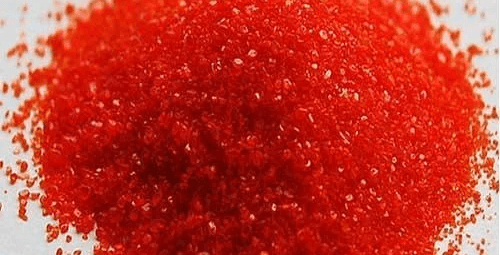
Properties and Preparation:
Kali Bichromicum, also known as Potassium Bichromate, is a homeopathic remedy derived from the chemical compound potassium dichromate. It is prepared using the process of potentization, where the substance is diluted and succussed (shaken vigorously) to create various potencies. In its homeopathic form, Kali Bichromicum is used to address a wide range of health issues, particularly those affecting the mucous membranes, respiratory system, digestive system, urinary tract, and joints.
Indications:
Kali Bichromicum has a special affinity for the mucous membrane of the stomach, bowels, and air-passages, as well as bones and fibrous tissues. It also affects the kidneys, heart, and liver. This remedy is indicated for conditions like incipient parenchymatous nephritis, nephritis with gastric disturbances, and cirrhosis of the liver. Characteristically, it presents with anemia and an absence of fever. The patients often experience general weakness bordering on paralysis. Kali Bichromicum is particularly suitable for fleshy, fat, and light complexioned individuals who are prone to catarrhs or have a history of syphilitic or scrofulous ailments.
Symptoms tend to worsen in the morning, with pains that migrate quickly and alternating between rheumatic and gastric manifestations. It is more suitable for subacute conditions rather than the violent acute stage. This remedy affects mucous membranes throughout the body, leading to catarrh of the pharynx, larynx, bronchi, and nose, characterized by a tough, stringy, viscid secretion. Other notable indications include perforation of the septum, chronic atonic catarrh, and the presence of polyps. It also addresses dilatation of the stomach and heart.
Kali Bichromicum is well-suited for complaints that arise in hot weather and for countering the bad effects of beer, which may lead to stomach-related issues like loss of appetite and flatulence. It proves beneficial in managing chronic sinusitis, chronic rhinitis, chronic tonsillitis, chronic throat catarrh, bronchial asthma, and periostitis. Patients may experience migratory pains that suddenly appear and disappear. Discharges from mucous membranes are typically tough, stringy mucus, or mucopus, which adheres to the affected area and can be drawn out in strings. Ulcers, both punched out and perforating, are common on the skin and mucous membranes. Swollen parotid glands and a relaxed uvula can also be addressed with Kali Bichromicum. Additionally, it is effective in alleviating violent, rattling coughs that last for a few minutes and may be accompanied by an effort to vomit.
Symptoms & Materia Medica:
Head:
In the realm of head-related symptoms, Kali Bichromicum exhibits distinct characteristics. Patients may experience vertigo coupled with nausea upon rising from a seated position. Headaches are prevalent, primarily located over the eyebrows and often preceded by blurred vision. Another noteworthy manifestation includes aching and fullness in the glabella region. Furthermore, individuals may suffer from semilateral headaches, appearing in small spots and commonly occurring over one eye. Additionally, the bones and scalp may feel sore, adding to the discomfort experienced in this area. These distinctive head symptoms are important indicators for considering Kali Bichromicum in homeopathic treatment.
Mental/Emotional:
Kali Bichromicum demonstrates an aversion to both mental and bodily exertion. Patients may experience a sense of prostration and sluggishness, leading them to avoid mental and physical activities. This aversion to exertion, coupled with feelings of weariness and lethargy, provides valuable insights into the emotional state of individuals who may benefit from Kali Bichromicum as a homeopathic remedy.
Eyes:
Kali Bichromicum is associated with several eye-related symptoms. Patients may experience supra-orbital neuralgia on the right side, causing discomfort around the forehead area. Swelling, burning sensation, and edema of the eyelids are common manifestations, adding to the overall eye discomfort. Another notable symptom includes a ropy and yellow discharge from the eyes. Ulcers on the cornea may be present, but interestingly, they are accompanied by no pain or sensitivity to light (photophobia). Kali Bichromicum also addresses croupous conjunctivitis, characterized by granular lids and the presence of pannus, a vascularized tissue growth on the cornea. Iritis with punctate deposits on the inner surface of the cornea may also be observed in certain cases. Patients may experience dryness, itching, burning, and redness of the conjunctiva, causing further discomfort. These eye-related symptoms serve as essential indicators for considering Kali Bichromicum as a potential homeopathic remedy for addressing various eye ailments.
Ears:
Swelling of the ears with tearing pains is a characteristic manifestation, causing discomfort and sensitivity in the affected area. Another significant symptom is the presence of a thick, yellow, stringy, and fetid discharge from the ear. This discharge may further contribute to the patient’s discomfort and indicate the need for Kali Bichromicum. Additionally, sharp stitches experienced in the left ear can be a notable indicator for considering this remedy in cases where such ear-related symptoms are prominent. These distinctive ear symptoms provide valuable insights into the potential benefits of Kali Bichromicum in addressing various ear ailments and discomfort.
Nose:
In children, especially in fat, chubby babies, the remedy addresses snuffles, offering relief from nasal congestion and discomfort. Patients may experience pressure and pain at the root of the nose, accompanied by sticking pain inside the nasal passages.
Another noteworthy indication includes an ulcerated septum with a round ulcer, leading to further nasal distress. Fetid smell and discharge are common symptoms associated with Kali Bichromicum, contributing to the patient’s discomfort. In some cases, inflammation may extend to the frontal sinuses, causing distress and a feeling of fullness at the root of the nose. The remedy also addresses dropping from the posterior nares, leading to persistent irritation and discomfort. Loss of smell, frequent hawking, and an inability to breathe through the nose may further indicate the need for Kali Bichromicum. Patients may also experience a profuse, watery nasal discharge, often accompanied by bouts of violent sneezing. These characteristic symptoms provide valuable insights into the potential benefits of Kali Bichromicum in addressing various nasal issues and discomfort.
Mouth:
Patients may experience dry and viscid saliva, leading to discomfort and a sensation of stickiness in the mouth. Notably, the tongue may present with specific characteristics, such as being mapped, red, shining, and smooth, while concurrently suffering from dysentery. This condition is accompanied by a broad, flat, indented, and thickly coated appearance of the tongue, contributing to the patient’s discomfort.
Another notable symptom includes a feeling of a hair on the tongue, adding to the overall oral distress. Additionally, patients may exhibit ulcers in the mouth or a dry, burning sensation, which can further indicate the need for Kali Bichromicum. These distinctive mouth-related symptoms provide valuable insights into the potential benefits of Kali Bichromicum in addressing various oral issues and discomfort.
Throat:
Patients may experience red and inflamed fauces, leading to a dry and rough sensation in the throat. Swelling of the parotid glands and relaxation of the uvula can cause discomfort in the throat region. Notably, pseudo-membranous deposits may form on the tonsils and soft palate, adding to the patient’s distress.
A burning sensation may extend from the throat to the stomach, contributing to discomfort and irritation. In cases of diphtheria, Kali Bichromicum can be beneficial, especially when profound prostration and a soft pulse are present. Moreover, discharge from the mouth and throat is observed to be tough and stringy, providing additional valuable insights for considering Kali Bichromicum as a potential remedy for addressing various throat-related issues and discomfort.
Stomach:
Patients may experience nausea and vomiting after consuming beer, indicating a potential intolerance to this beverage. Additionally, they may feel a heavy load immediately after eating, and a sensation as if digestion had stopped, leading to discomfort and unease. Gastritis and the presence of a round ulcer in the stomach can cause further distress. Stitches in the region of the liver and spleen may be present, adding to the discomfort in the abdomen.
Patients may develop an aversion to water and struggle to digest meat. Interestingly, there may be a desire for beer and acidic substances. In some cases, vomiting of bright yellow water may occur, providing essential insights into the need for Kali Bichromicum as a potential remedy for addressing various stomach-related issues and discomfort.
Abdomen:
Patients may experience cutting pain in the abdomen shortly after eating, leading to discomfort and unease. Chronic intestinal ulceration can cause persistent discomfort and distress in the abdominal region. Notably, soreness may be felt in the right hypochondrium, contributing to the overall abdominal discomfort. Painful retraction, along with soreness and burning sensations, may be present in the abdomen, further adding to the discomfort experienced. The abdomen may also exhibit sensitivity to even the slightest pressure, indicating potential inflammation or tenderness in this area.
These characteristic abdominal symptoms provide essential insights into the potential benefits of Kali Bichromicum in addressing various abdominal issues and discomfort.
Stool and Anus:
Patients may experience constipation, characterized by the passage of extremely hard feces, leading to very painful evacuation. Additionally, jelly-like and gelatinous stools may worsen in the mornings, causing discomfort and irregular bowel movements. In cases of dysentery, patients may suffer from tenesmus and pass brown, frothy stools, adding to their discomfort. A sensation of a plug in the anus may be present, further contributing to the discomfort in this area.
Periodic constipation with pain across the loins and brown urine may be observed, providing additional valuable insights for considering Kali Bichromicum as a potential remedy for addressing various stool and anus-related issues. Moreover, soreness at the anus, coupled with dry stools, can make walking painful for the patient, indicating the need for Kali Bichromicum in managing these specific symptoms and discomfort.
Urinary complaints:
Patients may experience a burning sensation in the urethra, indicating potential irritation or inflammation in the urinary tract. Notably, the urine may contain ropy mucus, causing discomfort and potential obstruction.
The urethra may become clogged, further adding to the urinary discomfort. In cases of kidney congestion and nephritis, the urine may appear scanty, albuminous, and contain casts, indicating potential kidney dysfunction. Pyelitis may be present, with urine mixed with epithelial cells, mucus, pus, or blood, providing valuable insights into the nature of the urinary issue. Additionally, patients may experience hćmatochyluria, where blood is present in the urine, suggesting possible kidney or urinary tract involvement.
Male:
Itching and pain may affect the penis, accompanied by the presence of pustules, causing discomfort and irritation. Additionally, ulcers with paroxysmal stitches may be observed, with worsened symptoms during the nighttime. A constriction sensation at the root of the penis may be prominent, particularly aggravated upon awakening at night. Syphilitic ulcers may also be present, characterized by a cheesy and tenacious exudation, indicating potential underlying infection. Furthermore, the remedy may influence the frequency and intensity of erections in male patients.
Female:
Women may experience yellow and tenacious leucorrhśa, a condition characterized by abnormal vaginal discharge. Pruritus of the vulva may be present, leading to itching and a burning sensation, causing discomfort and excitement. Additionally, prolapsus uteri, where the uterus descends from its normal position, may worsen in hot weather, adding to the discomfort. Soreness and rawness in the vagina may occur, particularly during menstruation that is too early, accompanied by giddiness, nausea, and headaches.
Respiratory:
Patients may experience a hoarse voice, particularly worse in the evening, indicating potential irritation or inflammation in the throat and vocal cords. A metallic, hacking cough may be present, leading to discomfort and irritation in the respiratory tract. Notably, the cough is accompanied by a profuse, yellow, glutinous, and sticky expectoration, suggesting the presence of excessive mucus. A tickling sensation in the larynx may contribute to the urge to cough.
Kali Bichromicum addresses catarrhal laryngitis cough with a brassy sound, adding to the discomfort in the throat and airways. In cases of true membranous croup, the condition may extend to affect the larynx and nares, causing further respiratory distress. Patients may experience a cough accompanied by pain in the sternum, which extends to the shoulders and worsens during undressing. Additionally, coughing may lead to pain at the bifurcation of the trachea, extending from the mid-sternum to the back, indicating potential inflammation and sensitivity in the respiratory passages.
Heart:
Dilatation of the heart, particularly when coexisting with kidney lesions, may be present, suggesting potential complications in the cardiovascular system. Additionally, patients may experience a cold feeling around the heart, which can be an uncomfortable and concerning symptom.
Back:
Patients may experience cutting pain through the loins, rendering walking difficult, and the discomfort extending to the groins. Additionally, pain in the coccyx and sacrum may be present, with the sensation extending both upwards and downwards.
Patients may find it challenging to straighten themselves due to the discomfort in the sacrum area. Moreover, pain may be felt in the coccyx when sitting, causing discomfort and unease.
Extremities:
Patients may experience pains that rapidly shift from one place to another, indicating a migratory nature of discomfort. Notably, wandering pains along the bones may worsen in cold weather, leading to added discomfort and sensitivity. For those suffering from left-sided sciatica, relief may be found with motion, suggesting potential relief through physical activity. Additionally, individuals may perceive their bones as feeling sore and bruised, adding to the overall discomfort in the extremities.
Complementary: Ars.
Remedies that follow well: Ant-t., Berb., Puls.,
Antidotes: Ars., Lach., Puls.
Relationship:
Compare: Tart emet, Brom, Hepar, Ind, Calc, Ant cr. In the production of false membranes, compare: Brom, Ammon caust, Sulph ac, Ipecac.
Inimical: Does not follow Calc.
Frequently Asked Questions (FAQ) about Kali Bichromicum:
Q: What are the primary uses of Kali Bichromicum as a homeopathic remedy?
A: Kali Bichromicum is primarily used to address health issues related to the mucous membranes, respiratory system, digestive system, urinary tract, and joints. It is often prescribed for conditions such as sinusitis, bronchitis, gastritis, urinary tract infections, and joint pains.
Q: How does Kali Bichromicum address respiratory complaints like cough and bronchitis?
A: Kali Bichromicum is known for its effectiveness in managing respiratory complaints, especially those involving a metallic, hacking cough with sticky, glutinous expectoration. It helps in relieving bronchial irritation, throat congestion, and symptoms worsened by cold weather.
Q: Is Kali Bichromicum effective in managing digestive issues, such as gastritis and ulcers?
A: Yes, Kali Bichromicum is commonly used to address digestive issues like gastritis and round ulcers of the stomach. It may be beneficial for individuals experiencing nausea, vomiting after beer consumption, and a sensation as if digestion has stopped.
Q: Can Kali Bichromicum help in relieving urinary complaints, such as burning sensation and infections?
A: Absolutely, Kali Bichromicum is useful for managing urinary complaints like burning in the urethra, clogged urethra, and pyelitis with mixed epithelial cells, mucus, pus, or blood in the urine. It may also address kidney congestion and nephritis with albuminous urine.
Q: Does Kali Bichromicum have any specific indications for male and female health concerns?
A: Yes, Kali Bichromicum has specific indications for male health concerns, such as itching and pain of the penis with pustules, and syphilitic ulcers with cheesy, tenacious exudation. For females, it is often used for conditions like yellow, tenacious leucorrhoea, pruritus of the vulva with burning, and prolapsus uteri worsened in hot weather.
Q: Are there any contraindications or side effects associated with the use of Kali Bichromicum?
A: As with any homeopathic remedy, individual sensitivity may vary, but generally, Kali Bichromicum is well-tolerated when used as per the recommended guidelines. However, it is essential to consult a qualified homeopathic practitioner for proper evaluation and personalized treatment.
Q: How should Kali Bichromicum be taken, and what are the recommended dosages?
A: The appropriate dosage and potency of Kali Bichromicum may vary depending on the specific condition and the individual’s response. It is usually available in various potencies like 6X, 30C, 200C, etc. It is advised to take the remedy as per the practitioner’s instructions or the product label.
Q: Can Kali Bichromicum be used in conjunction with other homeopathic remedies or conventional medications?
A: Kali Bichromicum can be safely used alongside other compatible homeopathic remedies, as per the guidance of a trained homeopathic practitioner. However, it is essential to inform the practitioner about any ongoing conventional medications to avoid any potential interactions.
Q: Is Kali Bichromicum safe for use in children and during pregnancy or breastfeeding?
A: Kali Bichromicum can be used in children, pregnant women, and breastfeeding mothers under the supervision of a qualified homeopathic practitioner. It is considered safe when prescribed appropriately, but individualized dosing and monitoring are essential.
Q: How long should one continue using Kali Bichromicum for chronic health conditions?
A: The duration of Kali Bichromicum’s use for chronic health conditions varies based on individual response and the nature of the condition. The practitioner will monitor progress and adjust the treatment plan accordingly. It is essential to follow up regularly to assess the remedy’s effectiveness and make necessary adjustments.
Books References:
- Materia Medica and Repertory” by William Boericke
- Synoptic Key of the Materia Medica” by Cyrus Maxwell Boger
- The Guiding Symptoms of Our Materia Medica” by Constantine Hering
- A Dictionary of Practical Materia Medica” by John Henry Clarke
- Kent’s Repertory of the Homeopathic Materia Medica” by James Tyler Kent
Please note that this repertory includes various symptoms and conditions that Kali Bichromicum may address. However, it is essential to consult a qualified homeopathic practitioner for individualized treatment based on the totality of symptoms and case history. Homeopathy is a highly individualized form of medicine, and remedies are prescribed based on the unique symptoms and constitution of the patient.
* Related Homeopathic Medicine *
Similar Posts
Zincum Picricum Homeopathic Medicine & Personality | Uses, Benefits & Indications
Zincum Phosphoricum Homeopathic Medicine & Personality | Uses, Benefits & Indications
Zincum Iodatum Homeopathic Medicine & Personality | Uses, Benefits & Indications
Zincum Bromatum Homeopathic Medicine & Personality | Uses, Benefits & Indications
Zea Homeopathic Medicine & Personality | Uses, Benefits & Indications
Zincum Aceticum Homeopathic Medicine & Personality | Uses, Benefits & Indications
Zincum Cyanatum Homeopathic Medicine & Personality | Uses, Benefits & Indications
Zincum Muriaticum Homeopathic Medicine & Personality | Uses, Benefits & Indications
Zincum Oxydatum Homeopathic Medicine & Personality | Uses, Benefits & Indications
Zincum Sulphuricum Homeopathic Medicine & Personality | Uses, Benefits & Indications

Phosphorus Homeopathic Medicine & Personality | Uses, Benefits & Indications
Causticum Homeopathic Medicine & Personality | Uses, Benefits & Indications

Top Global Homeopathic Medicine Manufacturers

Top renowned Homeopathic research institutes worldwide


